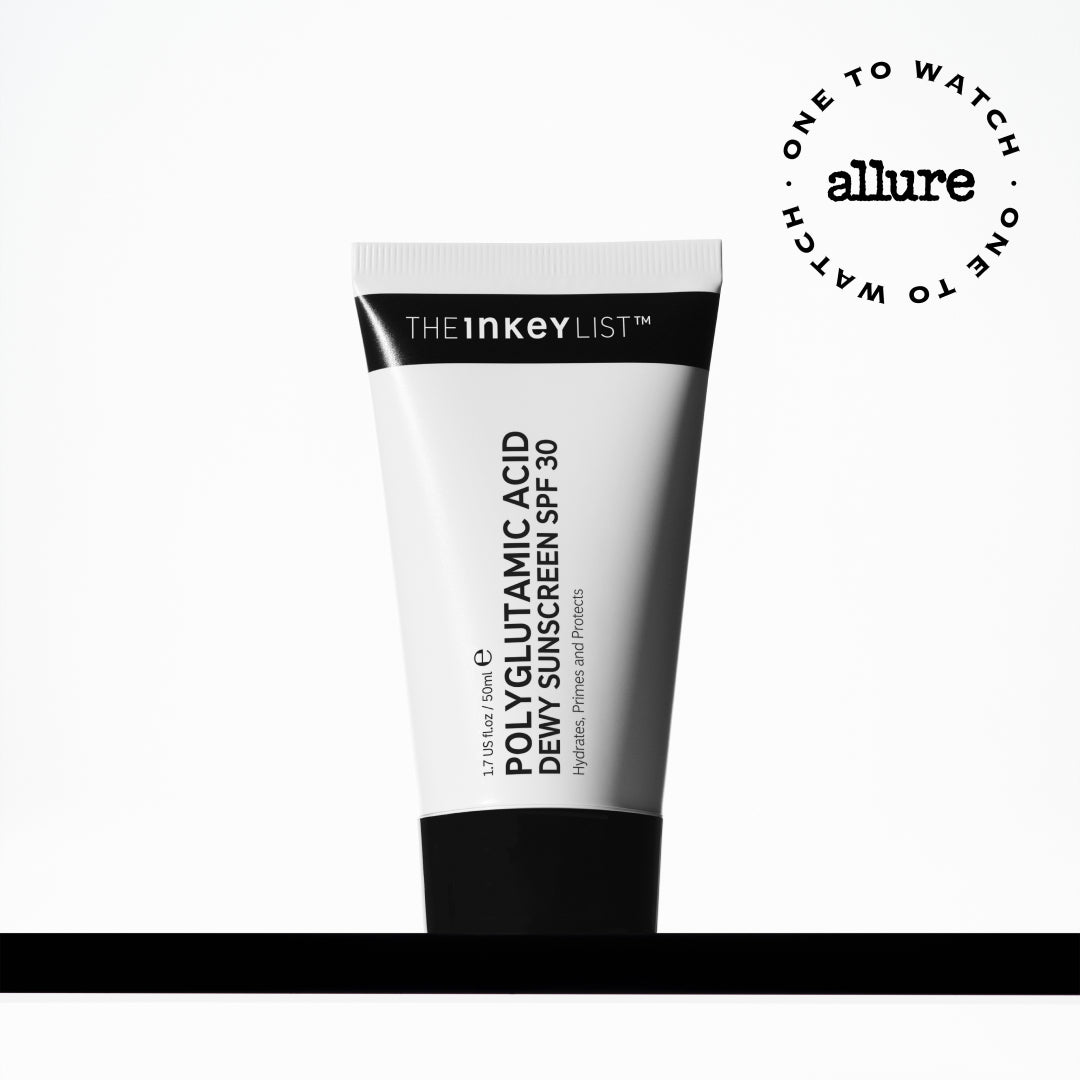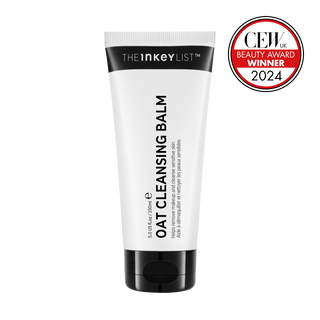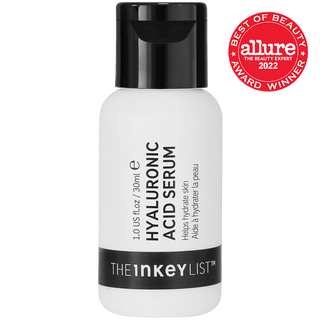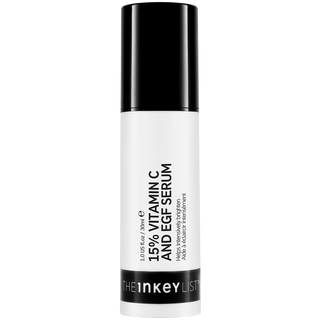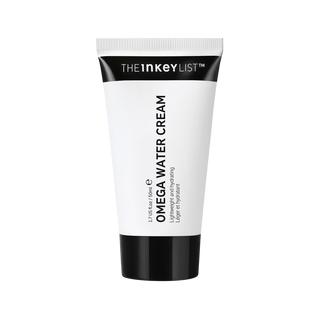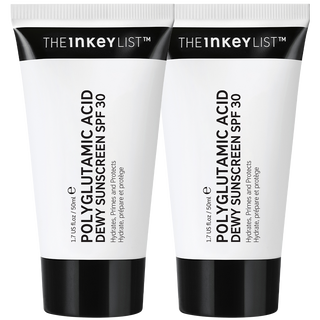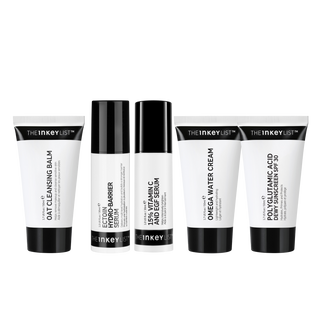Is this sunscreen mineral or chemical? This sunscreen uses only chemical filters to offer broad spectrum protection from UVA & UVB rays. There are no mineral filters in this product
How much should I use? For the face & neck, we recommend applying the product to 3 fingers first to get the right amount (this equates to about 3/4 of a teaspoon). SPF should be reapplied every 2 hours; or more frequently after swimming, perspiring or towelling.
Is it suitable for all skin tones? Yes, our Polyglutamic Acid (PGA) Dewy SPF 30 has a sheer, dewy finish. During our testing 97% respondents agreed it was invisible on their skin tone.
Why have we chosen SPF 30 over SPF 50? We wanted to create an SPF that would fit into everyone’s everyday routine as Step 5 to ensure everyday protection without compromising on dewy skin. We’ve worked hard to create a formula that balanced wearability with protection. After rigorous testing on multiple levels of SPF, this formula was the one that guaranteed to be truly suitable for all skin tones and types.
What is the true difference between SPF 30 and 50? Various research states that the SPF (sun protection factor) is a number that helps determine roughly how long you can stay in the sun for without burning vs your norm without protection. For example, if your skin would usually burn after 10 minutes of sun exposure, then an SPF 30 estimates protection for 300 minutes and an SPF 50 estimates 500 minutes of protection, however this can differ based on skin sensitivity and the strength of the sun rays.
Ultimately, broad spectrum SPF30 and above is commonly recommended for use by dermatologists globally, for daily (high) protection from the damaging effects of UVA & UVB rays. The key to ensuring you have maximum protection is using a product which is broad spectrum and strictly following the directions of use i.e. apply liberally and often.
If it’s only invisible on 97% of people then it must not be inclusive? We love the challenge on this and we’re always striving for 100%! We’re really proud of the formula behind this product and the testing results it’s achieved. We know that white cast can be a challenge with SPF but we were determined to overcome this challenge, and we’re confident we’ve achieved a formula that delivers on this, leaving the skin protected, dewy & hydrated.
During our 66 person user trial, 97% of respondents (whom represented a full spectrum of skin shades) agreed it was invisible on their skin tone. From the lightest to deepest of skin shades, respondents agreed our Polyglutamic Acid Dewy Sunscreen SPF 30 was invisible on their skin tone.
Should I wait before applying makeup? After applying the SPF, wait a couple of minutes for the product to absorb before applying your make-up.
How long should I leave between applying & sun exposure? We would recommend waiting 15 mins between applying the product and sun exposure. This is to let the SPF absorb into the skin for optimal protection.
How is best to reapply? If reapplying over makeup, we would recommend to reapply with a beauty blender and lightly dab all over the face until it's been absorbed, and each area is covered. Reapply frequently, especially after perspiring, swimming or towelling.
Is this suitable for oily skin types who do not like a dewy finish? Our PGA Dewy Sunscreen SPF 30 has been tested on all skin types, including those with oily skin. This product leaves the skin with a natural, hydrated, dewy finish.
Is this SPF non-comedogenic? Yes, we tested this product across all skin types and 95% of respondents agreed it was suitable for their skin type.
Can I apply PGA Serum in my skincare routine if I am using PGA SPF? Yes, we love the dewy skin! PGA Serum can still be used in your skincare routine, whether as a serum or mixed into your liquid foundation for a gorgeous, dewy base. As with any layering, we’d recommend leaving 1-2minutes between layers to allow them to sink into skin.
Can I add this SPF into my makeup/foundation as it contains SPF? How will this affect the protection? This product has been formulated as an SPF first and foremost and therefore it’s important that it’s applied properly & regularly to offer the correct protection. For this reason, this product should be applied alone as the last step in your skincare routine. It’s been formulated to leave your skin protected, primed and dewy, therefore giving you the perfect base for makeup.
We know many consumers love the hack our Co-founder Colette loves, mixing PGA into your foundation for the ultimate dewy finish. You can still do this to amplify your makeup finish even further!
What is the difference between INKEY’s Mineral SPF and PGA SPF? INKEY’s Mineral SPF uses a physical or inorganic non nano UV filter which reflects and scatters UV rays. It is pigmented to reduce whitening and leaves a matte finish to the skin. INKEY’s PGA Dewy SPF 30 uses organic chemical UV filters which is combined with an 8% Hydration Complex, including PGA, leaving the skin with a dewy finish.
What is the PH level of this product? 7.3 – 7.8 which makes this a neutral PH product.
Is this water resistant? No.
What does 8% Hydration trio actually mean? Is it a breakdown of the percentage of Polyglutamic Acid, Glycerin and Squalane? Is it 8% in total? What makes this product so powerful is the 8% hydration trio - Polyglutamic Acid, Glycerin & Squalane. As always, we’ve included PGA at an efficacious level to allow this product to deliver the benefits of PGA holding 4x more moisture than Hyaluronic Acid leaving skin hydrated and plump, with a smooth, dewy finish. These ingredients are included at efficacious levels within the product to give the formula this incredible texture and leave the skin hydrated, protected, primed and dewy.
Is it safe for pregnancy or breastfeeding? Yes.
Is it suitable for eczema/rosacea? Technically from a formula perspective yes, but we always recommend a patch test for anyone with a skin concern.
Does this product contain Silicones? Yes - Dimethicone and Dimethiconal.
What is SPF and how does it work? SPF stands for Sun Protection Factor. It is a measure of how much UV radiation is required to produce sunburn on SPF protected skin compared to the amount of solar energy required to produce sunburn on unprotected skin. As the SPF value increases, sun damage protection increases, protecting the skin from sun burn and photoaging (aging caused by sun rays, i.e. wrinkles, dark spots, etc). It works by either absorbing UV through chemical or organic UV filters to prevent harmful UVA and UVB rays from burning the skin or by reflecting, and scattering UV rays from physical or inorganic filters such as Titanium Dioxide or Zinc Oxide. Additionally you need to have a combination of UVA and UVB filters to ensure a Broad Spectrum Protection.
What does SPF 30 actually mean? SPF 30 allows 1/30th or 3.3% of UV to reach your skin.
In real terms, this means that if unprotected skin would take ten minutes to show signs of burning, then after properly applying SPF 30 sunscreen it would slow the rate of sun burn to the point where it would take 30 times longer.
Why have you used Octocrylene as a filter? Octocrylene is a safe, broad-spectrum filter which offers both UVA and UVB protection (some filters only offer one or the other) and was therefore one of the filters we opted for in our Polyglutamic Acid Dewy Sunscreen SPF 30 formula. Only UV filters which have gone through an extensive safety review by independent scientific experts, which takes several years, are allowed to be used in sunscreens and any other cosmetic product. All UV filters, including Octocrylene, are reviewed for safety by an independent scientific committee before they can be used in a sunscreen product. In addition, each individual product undergoes a stringent safety review by a professional and qualified assessor to ensure product is safe for a consumer.
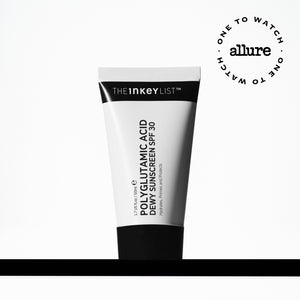







 All Skin Types
All Skin Types
 Sensitive Skin
Sensitive Skin
 Pregnancy & Breastfeeding
Pregnancy & Breastfeeding
 Carbon Net-Zero
Carbon Net-Zero
 B-Corp
B-Corp
 Cruelty Free
Cruelty Free
 Recyclable
Recyclable
 Vegan
Vegan
 Clinically Tested
Clinically Tested
 Dermatologically Tested
Dermatologically Tested
 Travel Size
Travel Size





